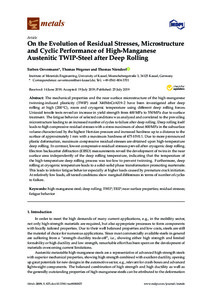On the Evolution of Residual Stresses, Microstructure and Cyclic Performance of High-Manganese Austenitic TWIP-Steel after Deep Rolling
| dc.date.accessioned | 2019-08-26T13:15:21Z | |
| dc.date.available | 2019-08-26T13:15:21Z | |
| dc.date.issued | 2019-07-25 | |
| dc.identifier | doi:10.17170/kobra-20190815627 | |
| dc.identifier.uri | http://hdl.handle.net/123456789/11290 | |
| dc.description.sponsorship | Gefördert durch den Publikationsfonds der Universität Kassel | ger |
| dc.language.iso | eng | eng |
| dc.rights | Urheberrechtlich geschützt | |
| dc.rights.uri | https://rightsstatements.org/page/InC/1.0/ | |
| dc.subject | high-manganese steel | eng |
| dc.subject | deep rolling | eng |
| dc.subject | TWIP | eng |
| dc.subject | TRIP | eng |
| dc.subject | near surface properties | eng |
| dc.subject | residual stresses | eng |
| dc.subject | fatigue behavior | eng |
| dc.subject.ddc | 620 | |
| dc.title | On the Evolution of Residual Stresses, Microstructure and Cyclic Performance of High-Manganese Austenitic TWIP-Steel after Deep Rolling | eng |
| dc.type | Aufsatz | |
| dcterms.abstract | The mechanical properties and the near surface microstructure of the high-manganese twinning-induced plasticity (TWIP) steel X40MnCrAl19-2 have been investigated after deep rolling at high (200 ∘C ), room and cryogenic temperature using different deep rolling forces. Uniaxial tensile tests reveal an increase in yield strength from 400 MPa to 550 MPa due to surface treatment. The fatigue behavior of selected conditions was analyzed and correlated to the prevailing microstructure leading to an increased number of cycles to failure after deep rolling. Deep rolling itself leads to high compressive residual stresses with a stress maximum of about 800 MPa in the subsurface volume characterized by the highest Hertzian pressure and increased hardness up to a distance to the surface of approximately 1 m m with a maximum hardness of 475 HV0.1. Due to more pronounced plastic deformation, maximum compressive residual stresses are obtained upon high-temperature deep rolling. In contrast, lowest compressive residual stresses prevail after cryogenic deep rolling. Electron backscatter diffraction (EBSD) measurements reveal the development of twins in the near surface area independently of the deep rolling temperature, indicating that the temperature of the high-temperature deep rolling process was too low to prevent twinning. Furthermore, deep rolling at cryogenic temperature leads to a solid–solid phase transformation promoting martensite. This leads to inferior fatigue behavior especially at higher loads caused by premature crack initiation. At relatively low loads, all tested conditions show marginal differences in terms of number of cycles to failure. | eng |
| dcterms.accessRights | open access | |
| dcterms.creator | Oevermann, Torben | |
| dcterms.creator | Wegener, Thomas | |
| dcterms.creator | Niendorf, Thomas | |
| dc.relation.doi | doi:10.3390/met9080825 | |
| dc.type.version | publishedVersion | |
| dcterms.source.identifier | ISSN 1996-1944 | |
| dcterms.source.issue | 8 | |
| dcterms.source.journal | Metals | eng |
| dcterms.source.pageinfo | 825 | |
| dcterms.source.volume | Vol. 9 |
Dateien zu dieser Ressource
Das Dokument erscheint in:
-
Artikel [1238]

